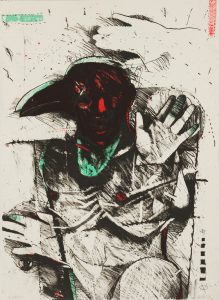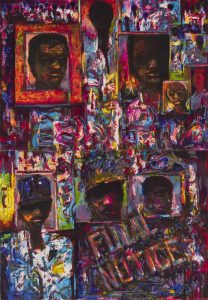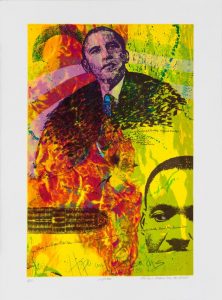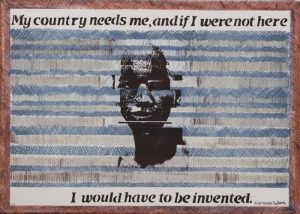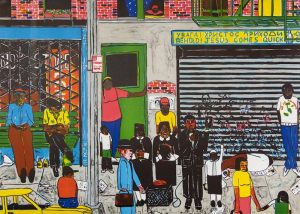Visual Literacy and Re-Imagining History
History: The Global Struggles for Freedom
There are at least three forms of OPPRESSION: marginalization, exploitation, and genocide. All three of these forms of oppression are acts of erasure. These are systematic attempts to deny an individual’s humanity. Marginalization assumes that an individual’s ability to perform a job is determined by their identity (Latin Americans are gardeners, African Americans are domestic servants, women are clerical assistants—while Native Americans are not seen as individual, living human workers but as symbolic mascots for sports teams, etc.). An example of marginalization is the prominent television news commentator who told LeBron James to “shut up and dribble.”
Marginalization claims to respect minorities as groups and individuals, but only to the degree that they successfully and cheerfully fulfill their preassigned roles. Anyone who dares step out of this stereotype is demonized. Artists canpresent powerful challenges to marginalization, but the power of art can also reinforce and confirm marginalization as well.
Exploitation is a process of dehumanizing a group of people to justify forcing them to provide labor and services at little or no pay. Slavery has been and is often justified on the basis of skin color, religion, or ethnic affiliation—those deemed to have undesirable identities are regarded as less than human and, therefore, they do not deserve equal treatment. However, the arts are color-blind. Through an image or a poem, an individual’s humanity can sing and be undeniable.
Genocide is the most brutal form of erasure. It attempts to deny the existence of a group of people by eradicating them—killing them and destroying all evidence of their lives. Artists fight against genocide by creating memories of people whom powerful forces have attempted to erase. Genocides have happened throughout history and continue to happen in the present day. The arts provide means of remembrance and warning so these horrific crimes are never forgotten and cannot be denied. In response to OPPRESSION, artists marshal their creative work as forms of RESISTANCE. Leaders like Martin Luther King advocated that the most powerful forms of resistance are nonviolent. The arts are especially effective forms of nonviolent resistance as they give voice to the human spirit, emphasize our shared humanity, present startling juxtaposi- tions by showing how oppression creates brutal realities for some and pleasure for others, and inscribe iconic aesthetic images that reverberate in our contemporary awareness and historical imaginations.
Related Artwork
Curriculum Connections
Suggested Topics for Social Studies and U.S. History
Social Studies and U.S. History
This print reflects the artist‘s desire to challenge stereotypes about Native American people — including the exploitative and caricaturing use of their names and images for sports and other commercial purposes — while the economic, educational, and cultural oppression of his people continues. The Black Lives Matter movement, which began in 2013 and gained increased urgency in in 2020, has focused renewed attention on stereotypes, marginalization, and oppression of people based on race, ethnicity, and religion. The awareness raised by Black Lives Matter has spurred many businesses to reexamine their branding and media strategies.
Questions to Consider
- What examples can you think of that further explores these ideas in real-time?
- Have you ever met or had a conversation with a Native American?
- The end of the Civil War started a period of aggressive westward expansion of the United States, war waged on Native American tribes by the U.S. army, and seizing or destroying natural resources. What impact did the mass slaughter of buffaloes by whites have on the survival and displacement of Native Americans?
Suggested Topics for Creative Writing
Expressive Writing
This print reflects the artist‘s desire to challenge stereotypes about Native American people — including the exploitative and caricaturing use of their names and images for sports and other commercial purposes — while the economic, educational, and cultural oppression of his people continues. The Black Lives Matter movement, which began in 2013 and gained increased urgency in in 2020, has focused renewed attention on stereotypes, marginalization, and oppression of people based on race, ethnicity, and religion. The awareness raised by Black Lives Matter has spurred many businesses to reexamine their branding and media strategies.
Questions to Consider
- Why are some people considered a threat while others are not?
- Why is there education inequality in most developed countries?
- Who benefits from stereotyping others?
Suggested Topics for World History and Visual Literacy
World History, Visual Literacy
The archives of history
have manifold reference points and are opening up to
public access to offer new narratives based on the
documents and evidence that exist, including first-
person notes and recorded interviews. As new
resources become available and new evidence comes
to light, an “archival fever” has arisen among artists who
incorporate found photographs and documents into
their artwork and offer profound, documented evidence
and versions of history that may have been hidden, denied, or misrepresented previously.
Our abilities as viewers to understand the messages and connections that the artists hope their imagery will convey is largely based on the extent of our own experiences and information that we bring to viewing and interpreting the artwork. In many countries, these types of messages are not brought to broad public attention and are often considered subversive.
Questions to Consider
- What role does protest-art play in society?
- How have artists participated in the subversion of authorities and/or the status quo?
- Do you know any examples of protest-art? Can you think of printed images that were created as acts of protest or subversion? Are there any in the Artura.org database?
- What is the origin of the word “ghetto”?
